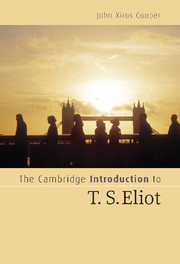Chapter 1 - Life
Published online by Cambridge University Press: 05 June 2012
Summary
Early life, 1888–1914
At East Coker in the English county of Somerset, St. Michael's parish church, situated on gently rising ground, looks out over a benign setting of trees, fields, and a scattering of ancient-seeming cottage roofs. On a warm, sunny day in late summer, it is easy to imagine oneself standing before a landscape unchanged for centuries. Only the presence of one or two cars in the church carpark and the encroachments of a new housing estate just visible in the far distance remind travelers that they are still very much in the twenty-first century. Inside, stained-glass illuminates, here and there, the dark interior. At the back, in the right-hand corner, a modest memorial marks the place in the wall where T. S. Eliot's ashes are interred. The poet himself chose this place for the deposition of his remains. The choice is significant. Here in this modest, virtually anonymous place, he enjoys eternity in an old village off the main track, in a church difficult to find, and in a place where no public sign or fanfare trumpets the presence of a celebrated author. Only when you enter the church do you know that you have arrived.
A visitor without any knowledge of the literary culture of the twentieth century might be excused for thinking that the “Thomas Stearns Eliot, Poet” remembered in St. Michael's was a minor figure, of limited importance, memorialized by an obscure parish in a small, out of the way village only for want of more famous native sons.
- Type
- Chapter
- Information
- The Cambridge Introduction to T. S. Eliot , pp. 1 - 21Publisher: Cambridge University PressPrint publication year: 2006

